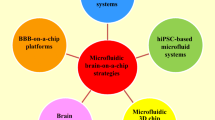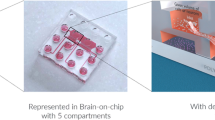Abstract
Millions of people worldwide have incurable and debilitating conditions called neurodegenerative diseases that influence one’s cognitive and/or motor functions. There is currently an increasing number of neuroprosthesis, but they have power consumption and bio-compatibility issues. To bring neuroprosthesis into realization and for future long-term replacement of damaged brain areas with artificial devices, understanding of neurophysiological behaviors and investigations on the interaction of neuronal cell assemblies is essential. To circumvent the limitations, in this article we propose a biomimetic artificial neuron to mimic and/or to replace the biological neurons. This biomimetic neuron is based on microfluidic technique with ionic exchange capable of performing bio-hybrid experiments.









Similar content being viewed by others
References
Nicolelis MAL, Lebedev MA (2009) Principles of neural ensemble physiology underlying the operation of brain-machine interfaces. Nat Rev Neurosci 10:530–540
Hochberg LR, Serruya MD, Friehs GM, Mukand JA, Saleh M, Caplan AH, Branner A, Chen D, Penn RD, Donoghue JP (2006) Neuronal ensemble control of prosthetic devices by a human with tetraplegia. Nature 442:164–171
Hochberg LR et al (2012) Reach and grasp by people with tetraplegia using a neurally controlled robotic arm. Nat Methods 485:372–375
Potter SM (2010) Closing the loop between neurons and neurotechnology. Front Neurosci 4:15
Levi T, Bonifazi P, Massobrio P, Chiappalone M (2018) Closed-loop systems for next-generation neuroprostheses. Front Neurosci 12:26
Bonifazi P et al (2013) In vitro large-scale experimental and theoretical studies for the realization of bi-directional brain-prostheses. Front Neural Circ 7:40
Joucla S et al (2016) Generation of locomotor-like activity in the isolated rat spinal cord using intraspinal electrical microstimulation driven by a digital neuromorphic CPG. Front Neurosci 10:67
Indiveri G et al (2001) Neuromorphic silicon neuron circuits. Front Neurosci 5:73
Levi T, Lewis N, Tomas J, Saighi S, Renaud S, Bornat Y, Alvado L (2008) Neuromimetic integrated circuits, VLSI circuits for biomedical applications, Iniewski Editor
Henrich-Noack P et al (2017) Electrical brain stimulation induces dendritic stripping but improves survival of silent neurons after optic nerve damage. Sci Rep 7:627
Pudenz RH, Agnew WF, Bullara LA (1977) Effects of electrical stimulation of brain. Brain Behav Evol 14:103–125
Mahowald M, Douglas R (1991) A silicon neuron. Nature 354:515–518
Le Masson G, Renaud-Le Masson S, Debay D, Bal T (2002) Feedback inhibition controls spike transfer in hybrid thalamic circuits. Nature 417:854–858
Ambroise M, Levi T, Joucla S, Yvert B, Saïghi S (2013) Real-time biomimetic central pattern generators in an FPGA for hybrid experiments. Front Neurosci 7:215
Levi T, Fujii T (2016) Microfluidic neurons, a new way in neuromorphic engineering? Micromachines 7:146
Unger MA, Chou HP, Thorsen T, Scherer A, Quake SR (2000) Monolithic microfabricated valves and pumps by multilayer soft lithography. Science 288(5463):113–116
Brewer GJ, Torricelli JR, Evege EK, Price PJ (1993) Optimized survival of hippocampal neurons in B27-supplemented Neurobasal, a new serum-free medium combination. J Neurosci Res 35:567–576
Ambroise M, Bucceli S, Grassia F, Pirog A, Bornat Y, Chiappalone M, Levi T (2017) Biomimetic neural network for modifying biological dynamics during hybrid experiments. J Artif Life Robot 22(3):398–403
Grassia F, Kohno T, Levi T (2016) Digital hardware implementation of a stochastic two-dimensional neuron model. J Physiol Paris 110(4):409–416
Ambroise M, Levi T, Bornat Y, Saighi S (2013) Biorealistic spiking neural network on FPGA. In: IEEE CISS 2013, Baltimore, US
Kawada J, Kaneda S, Kirihara T, Maroof A, Levi T, Eggan K, Fujii T, Ikeuchi Y (2017) Generation of a motor nerve organoid with human stem cell-derived neurons. Stem Cell Rep 9(5):1441–1449
Author information
Authors and Affiliations
Corresponding author
Additional information
This work was presented in part at the 23rd International Symposium on Artificial Life and Robotics, Beppu, Oita, January 18–20, 2018.
About this article
Cite this article
Nishikawa, S.M., Kim, S.H., Luo, Z. et al. Biomimetic microfluidic neurons for bio-hybrid experiments. Artif Life Robotics 23, 402–408 (2018). https://doi.org/10.1007/s10015-018-0452-z
Received:
Accepted:
Published:
Issue Date:
DOI: https://doi.org/10.1007/s10015-018-0452-z




